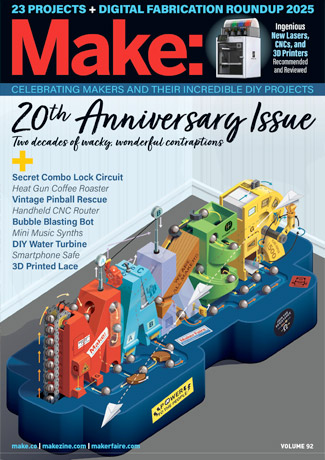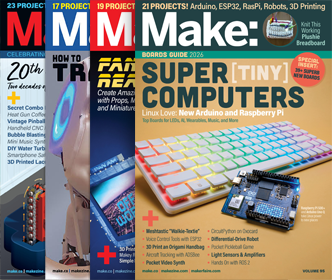
HOT NEW HOT END
The new all-metal hot end includes an additional blower aimed straight at the heat-break. Many Taz 4 users printed a mod to divert cooling air to the printed material to help combat heat-creep, especially with some less cooperative PLAs. With this hot end, there’s no need. Plus, being all-metal, it is rated to 300°C (up from 240°C), expanding the variety of materials to include various nylons, polycarbonate, and PETT.
The hot ends now ship with 0.50mm nozzle apertures, although the more standard 0.35mm is still available. The larger opening makes it easier to put out more plastic per layer — and thus take advantage of the nearly cubic foot of print volume more quickly. It also reduces the stress of printing the newer filaments that contain various powdered materials (bronze, copper, steel, iron, etc.).
Nylon? No problem. A little glue stick, download the profile from Lulzbot.com, slice, and print.
The firmware even includes a dozen or so presets for various materials. This is the sort of experience that makes a user eager to try interesting new materials.
However, that new capability comes with the arguable loss of some fine detail, though you can get the 0.35mm nozzle if you really want it. (In fact, the old hot-end is still available if you want that too.) And the Taz retains its easy-to-swap tool head design — undo one-screw, unplug a few cables, and you’re done. Although, depending on what you swap, you may have to change firmware to match.
Taz 5 comes with a very sharp-looking power supply with its own metal case and thermally triggered fan. It is shorter than the Taz 4 supply, but otherwise larger which depending on your situation may or may not add to the already quite substantial footprint of the system. The fan is quite audible, but on intermittently and not particularly whiny or annoying.
POLYAMOROUS
The PEI has no real color, but lets you see through to the orange silicone heater pad firmly adhered to the bottom of the borosilicate glass plate. At times, it can be rather difficult to read how far above the translucent print surface the nozzle really is. To the touch, the PEI seems like nothing special, a bit like an acid etched glass surface. But when the plastic hits it, the magic happens.
ABS and HIPS both stick admirably to the PEI around the recommended 110°C range, and PLA does even better. But what is delightfully surprising is that, back down around room temperature, HIPS and ABS pop right off. If you are not a believer, you may try to pry your prints off of this surface before it has cooled. Woe is you. And while some PLA is a bit tougher to detach, even at room temperature, once you get it started it can come off violently. Before you realize it, all that force you were applying to remove the print will drive your knuckles full force into the fresh, sharp, plastic edges of your print.
For materials that don’t play as nicely with PEI, particularly Nylons, some glue stick comes to the rescue. The printer’s industry-leading documentation offers a table of materials, temperatures (nozzle, bed, and removal) as well as whether or not to use a glue stick.
The PEI surface itself is quite tough, and if you avoid trying to forcibly remove prints from the hot surface, it doesn’t suffer the gouges, nicks, and peeling that the Taz 4 PET tape surface does. A replacement sheet is available for less than $20.
A CURA FOR WHAT AILS

CONCLUSION
It was hard to improve on the Taz 4, but a new hot end, a durable sticky-when-hot print surface, and some added, easy-to-use software options have certainly done it. Even better, the Taz 5 brings no controversial or ruinous downgrades to successful design. And while some may lament the lack of an automated platform level calibration, others may look at that as an unnecessary gimmick. The Taz 5 is a worthy successor, still true to its open heritage, and a match for any challenger.







